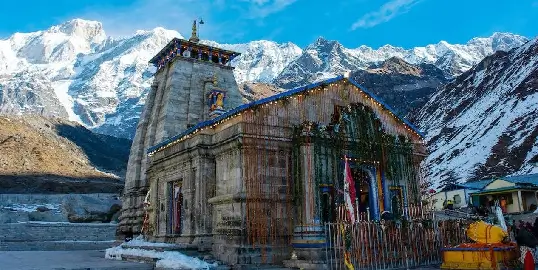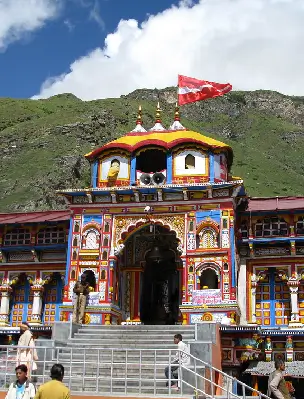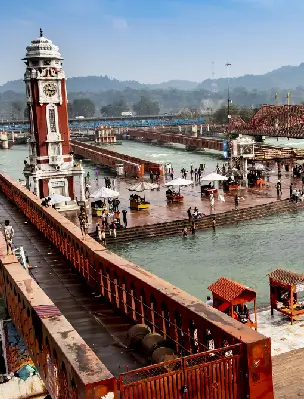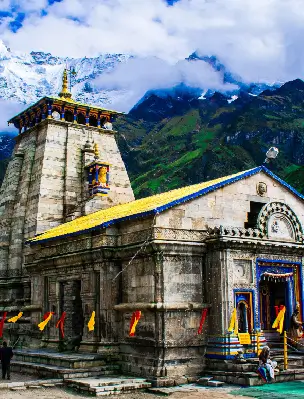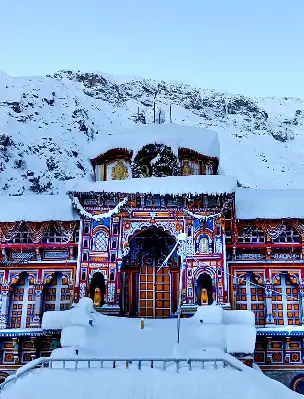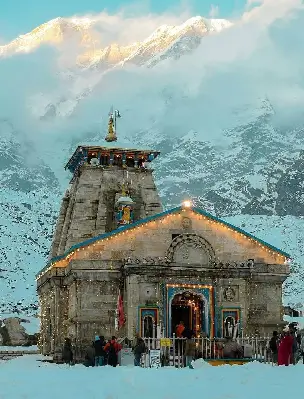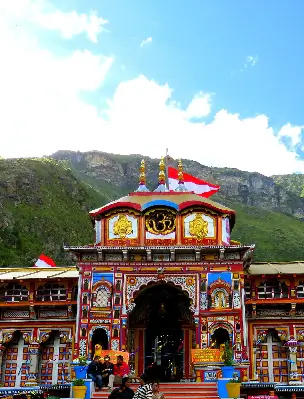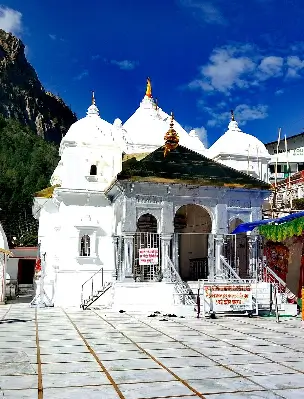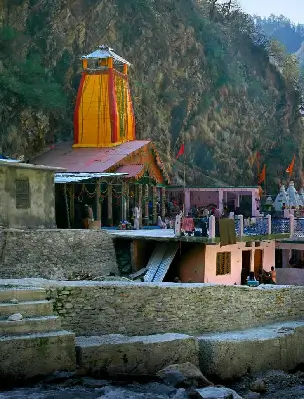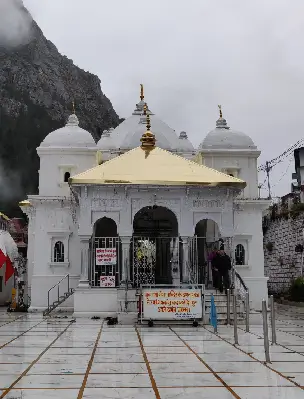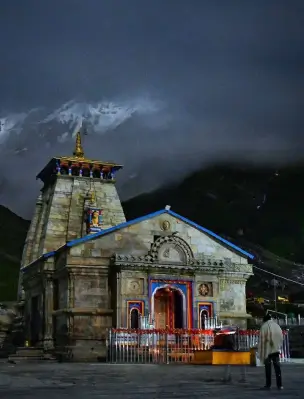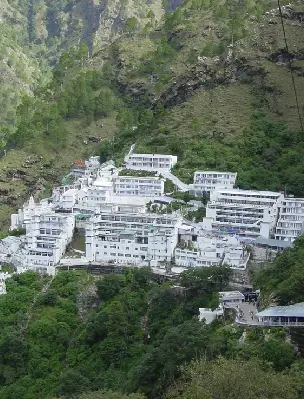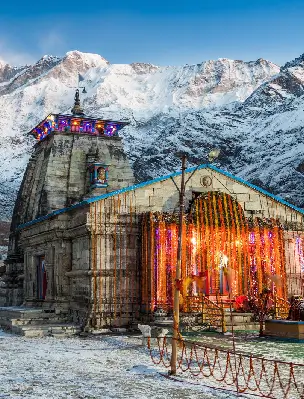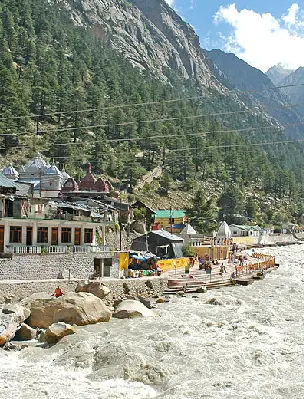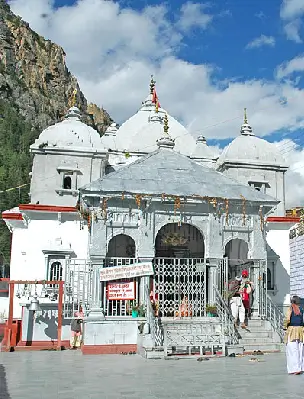Shri Kedarnath Dham

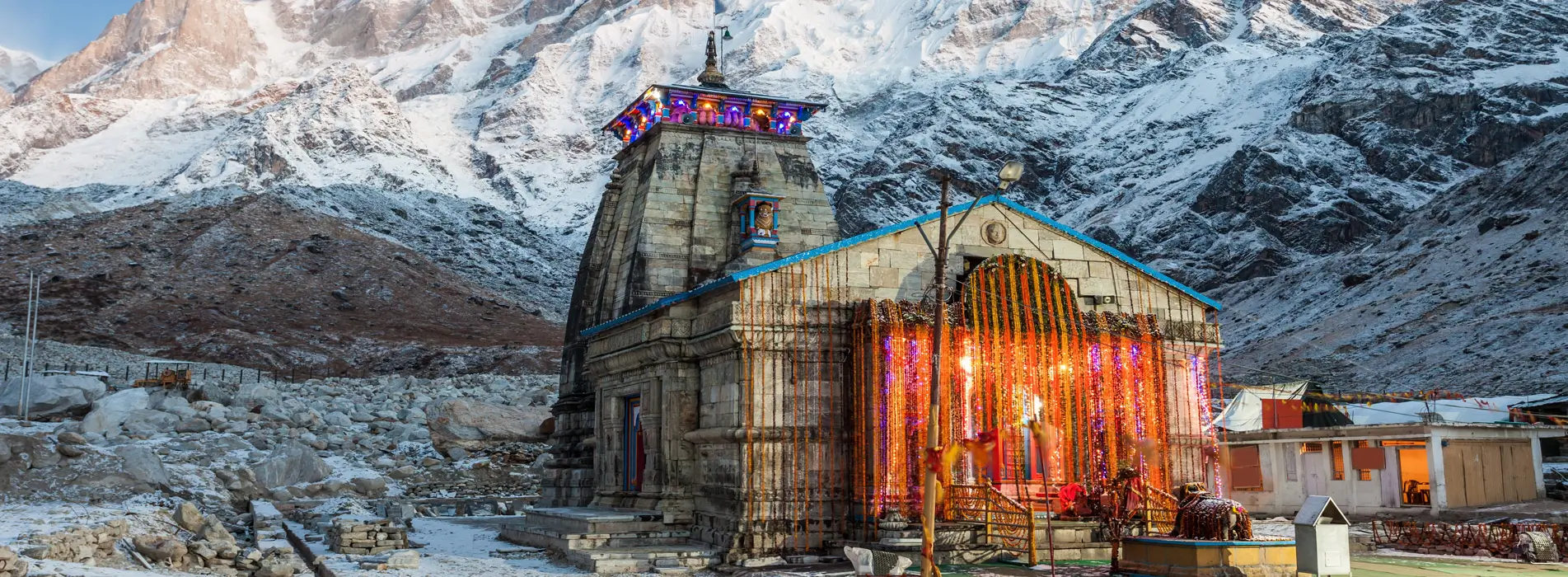



About Kedarnath Temple
Engulfed in the soulful chants of "Om Namah Shivay", the ringing sounds of the temple bells, and wrapped in a pious aura, Kedarnath Dham is an epitome of spirituality, peace and mysticism. The holy Hindu town, situated at a majestic height of 3584 metres above sea level near the head of the sacred Mandakini River in the state of Uttarakhand, is blessed with a bewitching scenery that makes the travellers lose sense of time. Every year, the place is thronged by millions of devotees seeking blessings of Lord Shiva at the ancient Kedarnath Temple, which happens to be the most important religious attraction and a focal point of all pilgrim activity in the town.
It is said that the temple was originally built by the Pandavas from the Mahabharata fame, but was consecrated in 8th century AD by Adi Shankaracharya on his excursion across the Garhwal Himalayas. Today, the temple is the most revered shrine of the enchanting Himalayan region and sits as an important part of the Chota Char Dham Pilgrim Circuit. Additionally, it's the first of the sacred Panch Kedar shrines and also one of the 12 Jyotirlingas dedicated to Lord Shiva
Kedarnath Dham holds a special place in the heart of every Hindu devout and Shaivite who yearns to visit this pious destination at least once in their lifetime. If you too are someone planning a pilgrimage tour here, note that the town is connected to almost every major city of Uttarakhand via a motorable road which extends till Gaurikund. Further up Gaurikund, one has to cover a paved yet gruelling pathway uphill of about 14 km. To do so, one can either embark on a trekking expedition, hire a pony or rent a palanquin which can be pre-booked from the GMVN office. Helicopter services are also available to Kedarnath.
Kedarnath Temple Opening Date 2025- 2 May
Recommended Tour Packages for Kedarnath Yatra 2025
History & Religious Significance of Kedarnath Temple
Nestled at a height of almost 12,000 feet, the present day structure of Kedarnath Temple is said to have been constructed by Hindu Guru Adi Shakaracharya in 8th century AD. However, the original shrine is believed to have existed since Vedic times and has various interesting legends and mythological stories associated with it.
According to one of them, Nar and Narayana, two incarnations of Lord Vishnu, once performed severe austerities and penance on the grounds of present day Kedarnath, seeking blessings of Lord Shiva. Pleased with their sheer devotion and prayers, Shiva appeared before them and asked them to make a wish. Extremely delighted, Nar and Narayana instantly requested Shiva to dwell permanently at Kedarnath. Since that time, Lord Shiva is believed to have been residing here in the form of a Shivlingam, freeing his true devotees from all the miseries of their life.
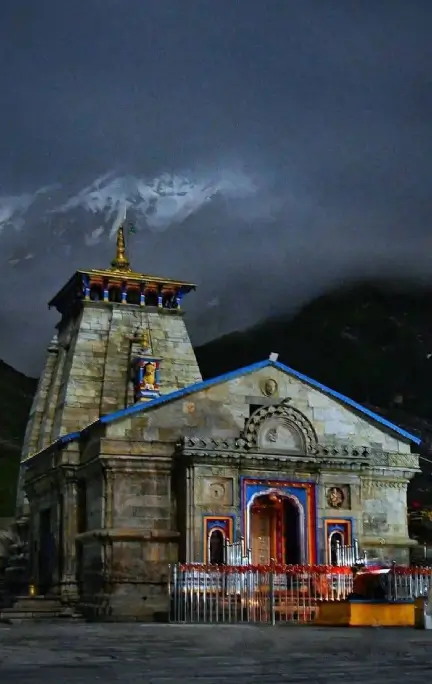
The second legend narrates that the temple came into existence during the time of Pandavas from the fame of Hindu epic, Mahabharata. According to the story, the Pandavas, burdened with the guilt at having killing their own cousins in the infamous war of Kurukshetra, sought forgiveness from Shiva. Not wanting to release the five brothers from the burden of their sins so easily, Shiva disguised himself in the form of a bull and eluded them repeatedly in the Garhwal Himalayas by hiding under the ground. Nevertheless, his hump was accidentally visible at a place, and Bhima was quick to recognize it. Ripping apart the two mountains amidst which Shiva hid, Bhima caught hold off his hump, and that is when Lord Shiva blessed the Pandavas, absolving them of all their sins. It is said that at the very site where this episode took place, Pandavas built a small temple and worshipped Shiva to attain salvation. The Shivalinga that is formed inside the temple is in the shape of a cone, and resembles the protruding hump of Shiva.
As per geologists, the Kedarnath Temple hid under the snow for 400 years during the little ice age, and came to be discovered many years later in the 8th century AD by the great sage, Adi Shankaracharya. Acknowledging the religious essence of the shrine, Shankaracharya consecrated the temple again and reinstated it to its original glory. Needless to say, Kedarnath Temple is today the most sacred Hindu pilgrimage shrine and is visited by millions of devotees every year seeking the path of salvation.
Kedarnath Yatra Opening Dates and Timings
The Kapat (temple doors) of Shri Kedarnath Ji Temple are opened for devotees every year in the months of April-May, precisely on the auspicious day of Akshay Tritiya. With the onset of winters, i.e. starting November, typically on the day of Kartik Purnima, the temple is closed for six months. The exact date of opening and closing, however, is formally decided and announced by the priests of the temple after calculation of the Panchang (Hindu religious calendar and almanac). For 2025, the tentative opening date of Kedarnath Temple is 2 May and closing date is November, the eve of Bhaiya Dooj. As for the daily timings, the temple remains open between 4.00 AM to 3.00 PM, and 5.00 PM to 9.00 PM every day. There's a two hours break between 3.00 PM and 5.00 PM, during which the temple kapat (doors) are closed to the general public the darshans
Pooja Timings in Kedarnath Temple
Being one of the most revered and sacred Shiva shrines, Kedarnath has a strict schedule of various poojas and sevas that are performed in the temple premises twice daily. The morning pooja begins at sharp 4.00 AM with the first ritual of "Maha Abhishek" followed by "Rudra Abhishek","Laghu Rudra Abhishek" and "Shodasopachar Pooja" continuing till 7.00 AM.
The evening sevas commence from 6.00 PM with the priests reciting 1008 names of Lord Shiva as part of the "Sahasranamam Path". This Path is further followed by "Mahimna Stotra Path", "Tandav Stotra Path" and finally the "Sampurna Aarti", all coming to a closure at 7.30 PM. While devotees can enjoy the Darshan of Shri Kedarnath Ji at the temple free of cost, those looking to do some special Pooja or aarti need to pre-book their schedule and deposit a specific amount in the temple trust.
Best Time to Visit Kedarnath Dham
The Kedarnath Temple is open for pilgrims only for a brief period of six months i.e. during summers, which is late-April until mid-November. Even during this timeframe, the months of May-June and September-October prove to be the most ideal, offering perfect ambience and pleasant weather. July to August happen to be the monsoon months, bringing heavy showers that often result in severe road blockages and landslides. However, Kedarnath Temple can be visited during this time too. It is worth noting that Kedarnath Temple is closed for the entire duration of winters i.e. beginning November until April. This is done due to harsh weather conditions and extreme snowfall that renders the town inaccessible.
How to Reach Kedarnath?
Kedarnath Dham is said to be the remotest and most difficult of the Char Dham Circuit of Uttarakhand. Having said so, it can still be reached by three modes of transport, the details of which are given below.
-

By Air : The nearest airport to Kedarnath Dham is the Jolly Grant Airport in Dehradun. It sits 238 km away from the temple town. Travellers can either board a state run bus or hire a private taxi up till Gaurikund, from where Kedarnath is 14 km hike uphill via a paved pathway.
-

By Road : Kedarnath is connected to all the major cities of Uttarakhand including Dehradun, Rishikesh and Haridwar via a motorable road that ends at Gaurikund. Further up Gaurikund, travellers need to hike a paved pathway for about 14 km. Those who want to avoid the trek can also opt for ponies, palanquins and dolis, which are easily available.
-

By Train : The nearest railway station is Rishikesh, located approximately 216 km from Kedarnath. Again, buses and taxis are easily available up till Gaurikund, from where it's an uphill climb till Kedarnath.
Introduction of Panch Kedar
Uttarakhand is often called "Dev Bhoomi" or the "Land of Gods". The enchanting Himalayan state has been blessed with a number of ancient and sacred temples, most of which are dedicated to Shiva, the Hindu God. Out of all his shrines, the cluster of five temples collectively known as "Panch Kedar" are the most revered, and are an important pilgrimage site.
According to Hindu mythology, after the battle of Kurukshetra, when Pandavas were burdened under the guilt of fratricide, they searched for Lord Shiva to atone for their sins. Shiva, however, was not happy with their deeds, and repeatedly eluded them by taking on the form of a bull. One day, Bhima, the second of the five Pandava brothers, was successful in recognizing Shiva in bull form. With the fear of being caught, Shiva decided to become invisible by diving into the ground. Yet, while doing so, he left his hump exposed. The place where the incident occurred is now worshipped as Kedarnath Temple. The Shivlinga that is venerated inside the temple even till date resembles the conical protrusion of the hump, unlike the usual form of Shiva Linga worshipped in other Shiva temples.
Besides the hump, four other parts of bull later appeared at different sites, all in Garhwal region of the Indian Himalayas - Tungnath is where the arms appeared, Madhyamaheshwar where the navel showed up, Rudranath where Shiva's face appeared and Kalpeshwar where his head and hair revealed. The Pandavas built the temples at all these sites, which later collectively came to be called as Panch Kedar. Many devotees of Lord Shiva, along with the Chota Char Dham Yatra, also take up the Panch Kedar Yatra to seek eternal blessings and the path to salvation.
Best Places to Visit in and around Kedarnath

Kedarnath is a religious getaway located in the Rudraprayag district of Uttarakhand. The holy town is steeped in spirituality with many ancient temples and shrines dotting it. Listed below are some of the town's best places to visit and important religious attractions that are a must on every pilgrim's itinerary.
Omkareshwar Temple : Located in the small village of Ukhimath, 59 km from Kedarnath, Omkareshwar Temple is one of the most sacred shrines of Uttarakhand and is the winter abode of Lord Kedarnath. In the winter season (November through April), when Kedarnath Temple remains closed, the deity of Kedareshwar is shifted to Ukhimath and is worshipped here for six months. The temple gets its name from an ancient Hindu legend which states that once an emperor and an ancestor of Lord Rama performed a severe penance standing on one leg for 12 years. At the end of the penance, Shiva blessed him by appearing in the form of Omkar (the sound of Om). Since then, the temple is called as the Omkareshwar Temple.
Bhairav Temple : Bhairav Temple, also known as the Bhairo Baba Mandir, is an ancient shrine in Uttarakhand dedicated to Rudra, the fierce manifestation of Lord Shiva. The shrine is located 800 metres further uphill the main Kedarnath Temple, and is believed to protect the entire Kedar Valley during the winter months when the main temple remains closed. Pilgrims and devotees visiting the Kedar shrine make sure to pay their obeisance in this holy temple as well.
Gaurikund : Gaurikund is a small settlement that serves as the base camp for trekking to the pious Kedarnath Dham in Uttarakhand. The place is named after Goddess Parvati and is said to have been the very site where in Puranic times, she indulged in a hard penance to win over Shiva's heart. Pleased by her devotion, Shiva too admitted his love for her and accepted her as his wife. The ancient Gauri Devi Temple in the town stands as a testimony to this legend and is visited by every pilgrim enroute to Kedarnath.
Triyugi Narayan : While Gaurikund is the place where Lord Shiva accepted to take Goddess Parvati as her consort, it is at the village of Triyugi Narayan where the wedding actually took place. Perched at an elevation of 1980 metres above sea level, the village is a pristine site offering panoramic views of the surrounding mountain range. The hamlet lies close to Kedarnath and makes an important religious centre for devotees partaking the Chota Char Dham Yatra. The prime attraction of the village is the Triyugi Narayan Temple, which is famed to be built by Lord Vishnu to serve as the venue for the celestial wedding. An important highlight of the temple is a perpetual fire which is believed to have been burning in the temple courtyard since Vedic times. Besides, there are three holy bathing ponds (kunds) in the courtyard, which are bestowed with medicinal properties. It is ceremonial to take a dip in these kunds before entering the temple premises.
Vasuki Tal : Vasuki Tal is a pristine glacial lake situated at an altitude of 14,000 feet above sea level. Soaked in immense serenity and calm, the lake is a must visit attraction near Kedarnath and has an interesting mythological legend associated with it. It is said that in Puranic times, Lord Vishnu bathed in its pure waters on the auspicious festival of Raksha Bandhan. Even till date, the lake exudes a magical charm and exudes a divine aura that captivates every traveller's soul and heart.
FAQ's
The sacred Kedarnath Temple is located in the Garhwal Himalayas, about 12,000 feet above sea level, near the Chorabari Glacier in Rudraprayag District of Uttarakhand. The place lies almost 216 km from the holy town of Rishikesh and can be accessed via a motorable road extending till Gaurikund.
Yes, Kedarnath Dham is also accessible by helicopter. We at Tour My India can assist you with the booking for helicopter services.
Kedarnath Temple is one of the most sacred Shaivite shrines and opens for tourists on the day of Akshay Tritiya during April-May. The temple is closed on the auspicious day of Bhai Dooj somewhere in October-November, with the onset of winters.
Popular Tours
Book The Tour
Char Dham Temples
Hotels in Chardham Circuit
Char Dham Tour Packages
- Char Dham Yatra From Delhi
- Chardham Yatra From Mumbai
- Char Dham Yatra From Ahmedabad
- Chardham Tour with Hemkund Sahib
- Chardham Yatra by Helicopter
- Char Dham Yatra with Vaishno Devi & Amritsar
- Chardham Tour with Gomukh Trek
- Char Dham Packages From Bangalore
- Chardham Yatra From Chandigarh
- Char Dham Yatra with Auli
- Char Dham Yatra From Hyderabad
- Char Dham Yatra with Vaishno Devi, Jwalaji & Amritsar
- Char Dham Yatra From Chennai
- Chardham Packages From Bhopal
- Char Dham Yatra by Luxury Vehicle
- Char Dham Yatra with Satopanth Lake
- Char Dham Yatra with Panch Badri Tour
- Char Dham with Valley of Flowers
- Chardham Yatra with Mahavatar Baba and Nainital Tour
Do Dham Yatra
- Badrinath Kedarnath Yatra From Haridwar
- Badrinath Kedarnath Yatra
- Gangotri Yamunotri Yatra
- Gangotri Yamunotri Yatra from Haridwar
- Kedarnath Badrinath Yatra with Hemkund Sahib
- Kedarnath Badrinath Yatra with Valley of Flowers
- Kedarnath, Badrinathdham With Lake Of Nainital
- Yamunotri, Gangotri with Lake of Nainital
Ek Dham Yatra
- Badrinath Pilgrimage Tour
- Kedarnath Pilgrimage Tour
- Gangotri Pilgrimage Tour
- Yamunotri Pilgrimage Tour
- Kedarnath Yatra By Helicopter
- Badrinath Dham Yatra from Haridwar
- Badrinath Yatra with Hemkund Sahib
- Badrinath Yatra with Valley of Flowers
- Gangotri Dham Yatra with Gaumukh
- Kedarnath Dham Vasuki Tal Trek
